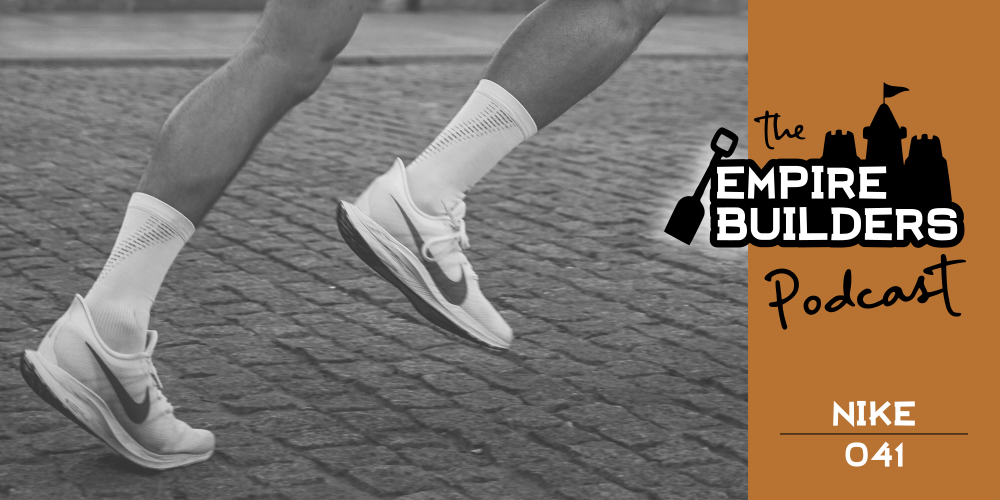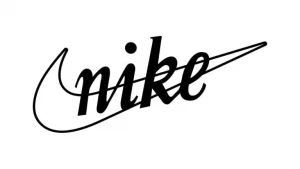
Subscribe: Apple Podcasts | Google Podcasts | Amazon Music | Blubrry | RSS | More
It was always about the runner. Nike goes from distributor to shoe manufacturer to work directly with the customer.
Dave Young:
Welcome back to the Empire Builders Podcast. I’m Dave Young, and Stephen Semple and I are talking about Nike today.
Stephen Semple:
Guess what their revenue was in their first year?
Dave Young:
Their first year.
Stephen Semple:
In their first year.
Dave Young:
Oh gosh, no idea.
Stephen Semple:
8,000 dollars.
Dave Young:
$8,000. So he was a thousandaire by the time of that.
Stephen Semple:
He was a thousandaire and then the next year was $20,000. It took them seven years to break a million bucks.
Dave Young:
Wow.
Stephen Semple:
Today $40 billion in sales and the company is worth 240 billion dollars and it took them that long to get to a million. Their early days are a real struggle. So Nike was founded by Phil Knight and Bill Bowerman on January 25th, 1964, and it was originally called Blue Ribbon. It was called Blue Ribbon until 1971 when it changed its name to Nike. And the name Nike came later and was inspired by the Greek goddess of victory.
And Phil when he was in university, this is a really, really interesting thing because where he first got the idea for doing shoes was when he was in university. He did a paper studying how Japan became really big in the automotive industry. And he looked at that and he said I can do that with shoes. Looked at another industry, looked at shoes and he was a runner. So he was familiar with the shoe business and said I can do that with shoes.
And he went to Japan. So he went to Japan and he started first of all, as a distributor for a Japanese shoe manufacturer, Onitsuka Tiger. He built a business as just a distributor of these shoes and this actually went on to become a bit of a source of ongoing tension because Phil and Bill were actually more than just distributors. They actually brought a lot of design changes, including one of their early design changes was this whole idea of this waffle sole. And that was really brought by Phil and his partner.

Then one day they realized because they were constantly having this struggle with the manufacturer, they wanted to have exclusive distribution rights. Manufacturer wouldn’t give them exclusive distribution rights. There was all of these issues and one day they realized what they needed to do was deal direct with the consumer. They had to take over the destiny and not just be a distributor any longer. And that happened in 1971 and that’s when they launched Nike, and that’s when the swoosh first came on the scene and that was trademarked in 1974. And it was also interesting, early versions of the swoosh actually had the Nike name actually in the swoosh. It was a little bit different than what it is today. They did eventually remove the name and in 1976 they opened their first retail store in Santa Monica.
But here is the interesting thing. For a whole bunch of years, Phil was only working part-time for Nike. He was not their full-time employee. There was a whole bunch of full-time employees before he was full-time with Nike. He worked as an accountant for a whole bunch of years because he could not afford to pay himself. All the money was plowing back into the business and growing the business, and so for years he worked as this accountant until he reached the stage where he said I can’t do both and I need to be with Nike full time.
And in 1976, they started doing some really interesting things. Because in 1976, they opened this retail store in Santa Monica and they also hired their first ad agency, which was John Brown and Parker, which created this campaign. No finish line campaign and this was a really innovative campaign because before that all the campaigns showed the product, showed the shoes. This campaign did not show the shoes, right? It was all about the runner. Didn’t show the shoes. And by 1980 Nike became 50% of the shoe market. They needed to go public.
And it’s really interesting. There’s a great book, Phil Knight’s autobiography called Shoe Dog. I highly recommend people read it. One of the things I love about the book is each chapter is a year. And one of the things is there were several times that they faced this question of going public and didn’t want to do it because they didn’t want to lose control of the business. But they finally reached a stage where they needed the capital injection, because if there was any stumble or anything like that, they just wouldn’t have been able to survive because of the speed they were growing at and things along that lines.
They then go public and in 1988 they debuted the Just Do It campaign and the Smithsonian ranks that as one of the top five slogans of all time. And that was created at Wieden and Kennedy. And here’s the fun thing about that. So we talk about how Phil Knight looked at the auto industry and went, wow, we could do that in shoes. Well, the inspiration for the Just Do It slogan came from the last words of Gary Gilmore and Gary Gilmore was being executed and said, “Let’s do it.” That was his final words. What are your final words? Let’s do it. And that was the inspiration for the Just Do It campaign.
So today Nike’s doing 40 billion in sales and we were saying it’s worth 240 billion dollars. And today Phil Knight is still one of the largest shareholders and he’s estimated to be worth over 50 billion dollars today and he went all of these years not making anything. First year, not bad for a part-time accountant. First year, 1300 pairs of shoes sold $8,000. The next year $20,000. Started in ’64, took to 1971. They broke a million, took them seven years to break a million. Nine years after that, they’re 50% of the shoe market in the United States.
Dave Young:
Of athletic shoes or the shoe market total?
Stephen Semple:
I believe shoe market total, but probably athletic shoes. Actually, when I think of it probably athletic shoes. Yeah.
Dave Young:
It’s just amazing.
Stephen Semple:
Yeah. And the thing here that I always find interesting, and we hear this over and over again. And I heard a story recently from one of our friends, Brian Scudamore. So Brian who owns 1-800-GOT-JUNK? and is also a self-made billionaire, he’s had an opportunity now to meet with other really successful billionaires and what they all talk about is the first million is the hardest. It’s easy to go from a hundred million to a billion. It’s easy to go from 10 million to a hundred million. The first million dollars is the hardest. And it took Nike seven years to break that, and then very quickly accelerated after that.
And what drives me crazy is the number of times we’ll get startups coming to us and almost always, almost always… And we’ve got actually a story coming up in the future that echoes this almost always is, oh yeah, our first year we’re going to do a million dollars. I am amazed the number of times I see that as the first year and the first million is the hardest. Absolute hardest, it often takes many, many years to get to that million and then things start to accelerate.
Dave Young:
I think you have to do what Phil did and prove that you got something that people want.
Stephen Semple:
That’s like the spring free trampoline, right? There was all these things that they did even before bringing the product to prove it out. Now, the other thing is you have to be realistic about what the beginning years are like. And it’s amazing with how many of these empires that we look back at, there’s those first bunch of years are hard and the numbers are small. You’ve just got to push it. Intel, what was its first year? Was like 1700 bucks that they made and that’s just the reality of the beginning years.
Here’s the other thing that’s beautiful about the book Shoe Dog, it is really well written. It’s an enjoyable read. I actually had a hard time putting it down, but the thing that’s cool is Phil Knight looked at another industry. Auto industry, Japan said holy smokes, that can work for shoes. The other thing that they figured out was at a certain point they had to be in the driver’s seat. It had to be their brand where they were dealing directly with the consumer. They couldn’t just get to where they wanted to go and do what they wanted to do and find that vision that they had by being a distributor of somebody else’s product.
Dave Young:
Thanks for listening to the podcast. Please share us. Subscribe on your favorite podcast app and leave us a big fat juicy five star rating and review. And if you have any questions about this or any other podcast episode, email to questions@theempirebuilderspodcast.com.
- Tapping Into the Zeitgeist: Monopoly’s Origin Story - December 17, 2025
- From Mars Men Mediocrity to Sour Patch Success - December 10, 2025
- The Hidden Psychology Behind Cabela’s Success - November 28, 2025
